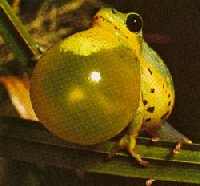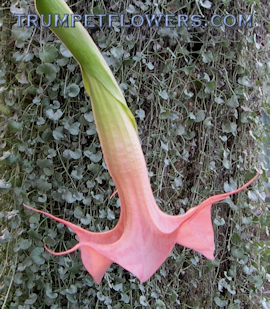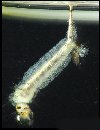Caresheet Reedfrogs
 Over 200 species of reed frogs abound throughout Africa. Unusually, they are diurnal, although any will leap quickly into the pool beneath them if startled.
In breeding season, the males will also take up to singing in the evenings as well. Somewhat strange among frogs, the females also sing, but do not have the well developed vocal sacs of the males.
Over 200 species of reed frogs abound throughout Africa. Unusually, they are diurnal, although any will leap quickly into the pool beneath them if startled.
In breeding season, the males will also take up to singing in the evenings as well. Somewhat strange among frogs, the females also sing, but do not have the well developed vocal sacs of the males.
During the dry season the sedge, or reed frogs; will retire to crooks and crannies of nearby rock ledges or dig into the soft earth where moisture can still be found. There they will await the return of the monsoonal rains.
An interesting habit of the Arum reed frog is worth mentioning. It is so named because of it's natural habit to bask amoung the flowers of the arum lily, awaiting any unwary flying insect that comes his way. The frog is the same color as the lily (white) and therefore camoflauged mixed inbetween the flowers. When the arum lilies die down, the frog then moves over to other plants nearby, and takes on the coloration of the new plants. For this reason, one may wish to plant up their vivaria with arum lilies if keeping this species. When your blooms die, place other types of blooming African lilies in the vivarium to allow the frog more security and a colorful show for you!
Setup
Ideally, this frog species should have a treefrog style setup, taller than wider. Because it lives near or over water, a large pool is required.
If you have the space, a custom acrylic tank measuring 2' x 2' x 4' would be
perfect. Even though these are small frogs, no species being larger than 1.6", the large tank will ensure healthy, happy pets that will allow you to observe them. If you can set up the aforementioned acrylic setup, you could place a

 large pool in the front of the tank, and a Scotts ground peat moss earthern bank towards the rear. Ideal plants for their vivarium would include
large pool in the front of the tank, and a Scotts ground peat moss earthern bank towards the rear. Ideal plants for their vivarium would include 
 Bamboo,
Bamboo,

 papyrus,
papyrus,

 pistia,
pistia,

 water hyacinth and water lilies. Plant all that you use lushly, and allow the papyrus to actually be planted in clay pots (whose soil is held inside by wrapping in cheese cloth) just inside the water's edge.
water hyacinth and water lilies. Plant all that you use lushly, and allow the papyrus to actually be planted in clay pots (whose soil is held inside by wrapping in cheese cloth) just inside the water's edge. 
 Moss makes a good ground cover, providing you use good lighting. Since these are diurnal frogs, UVB lighting is acceptable, even beneficial. Doing these things, you have duplicated their environment as much as possible. These frogs are not good swimmers, so make sure they have water plants to land on and be able to climb out of the water if needed.
Moss makes a good ground cover, providing you use good lighting. Since these are diurnal frogs, UVB lighting is acceptable, even beneficial. Doing these things, you have duplicated their environment as much as possible. These frogs are not good swimmers, so make sure they have water plants to land on and be able to climb out of the water if needed.
 If you cannot set up the large tank, one must still remember that this is a quite active little frog that loves jumping. So even store bought, get nothing smaller than a tall 55 gallon to house one to six frogs. Make sure that it is placed in a room that receives little daytime traffic, and is away from cold drafts. Do not allow direct sunlight to touch the tank, but indirect sunlight is fine.
If you cannot set up the large tank, one must still remember that this is a quite active little frog that loves jumping. So even store bought, get nothing smaller than a tall 55 gallon to house one to six frogs. Make sure that it is placed in a room that receives little daytime traffic, and is away from cold drafts. Do not allow direct sunlight to touch the tank, but indirect sunlight is fine.
Place two daylight style fluorescent light strips over the screened top, and one basking (use a plant bulb) lamp, clipped onto one side. Give them 12 hours of daylight, and 12 hours of twilight.
Sterile grapevine logs with several  small holes to provide hiding spaces are needed to allow
the frogs to feel secure. Allow plants like
small holes to provide hiding spaces are needed to allow
the frogs to feel secure. Allow plants like 
 philodendron to wind around the grape logs. As an alternative, you could make slate "banks" by piling slate sheet rocks atop one another for hiding. Just be sure that none of them can topple or shift, which could accidentally kill a frog inside the cracks created by this design.
philodendron to wind around the grape logs. As an alternative, you could make slate "banks" by piling slate sheet rocks atop one another for hiding. Just be sure that none of them can topple or shift, which could accidentally kill a frog inside the cracks created by this design.
Keep the tank temperature between 76° and 84°. Night temperatures should never drop below 73°. Use a herp style heatmat to heat the tank from beneath, but be sure it is not placed over their pool. Clean the pool by emptying of water and then wiping the sides clean with a paper towel. Refill with treated water or
 rain, spring water. This is assuming you don't have a large pool with undergravel filter, which in this case the water will cleanse itself. Water changes in that case are only partial, and 1/2 every 2 weeks being changed is sufficent.
Keep all water devoid of fish and snails. If you have a large filtered pool, addition of water plants like elodea are welcomed.
rain, spring water. This is assuming you don't have a large pool with undergravel filter, which in this case the water will cleanse itself. Water changes in that case are only partial, and 1/2 every 2 weeks being changed is sufficent.
Keep all water devoid of fish and snails. If you have a large filtered pool, addition of water plants like elodea are welcomed.
 Hygrometer readings should be between 50 and 65 in spring and summer, and let that drop to between 40 and 45 in fall and winter, especially if breeding a colony is on your mind. In that case, also see the Rainchamber and
Frog Breeding page.
Hygrometer readings should be between 50 and 65 in spring and summer, and let that drop to between 40 and 45 in fall and winter, especially if breeding a colony is on your mind. In that case, also see the Rainchamber and
Frog Breeding page.
Feed the frogs fruitflies, 
 aphids, young caddis flies, pinhead to very young crickets, treehoppers,
aphids, young caddis flies, pinhead to very young crickets, treehoppers,  leafhoppers and mayflies. If your screen top is very secure and holes small enough in size, and you have an undergravel filter in the pool, try dropping some mosquito larvae in the water. When they metamorph, the reed frogs will have a meal awaiting! Feeding them every other day, all they can eat, is a good regiment. Remove any bugs that end up dying a couple of hours after initially offering them.
leafhoppers and mayflies. If your screen top is very secure and holes small enough in size, and you have an undergravel filter in the pool, try dropping some mosquito larvae in the water. When they metamorph, the reed frogs will have a meal awaiting! Feeding them every other day, all they can eat, is a good regiment. Remove any bugs that end up dying a couple of hours after initially offering them.
Do not handle this anuran unless absolutely necessary, and then use Proper procedures.
A few species List
Afrixalus spinosus African wart frogAfrixalus fornasinii Greater leaf folding frog
Hyperolius horstockii Arum frog
Hyperolius marmoratus Painted reed frog
Hyperolius tuberilingius Green reed frog
Hyperolius quinquevittatus Five lined reed frog
Hyperolius virdiflavus Painted reed frog
Heterixalus betsileo Bestileo reed frog
Kassina Maculata Red Legged Running Frog
Further Onsite Help
Basic Frogcare (choosing healthy frogs, species mixing, feeding, etc.)
Vivariums (to establish and maintain, lighting, substrate ideas, etc.)
Quarantine (keeping vivarium disease-free, how to set up quarantine tank)
Water 101 (How to establish & maintain high quality water)
Raising Insects (Info about raising your own insects, including aphids)
Frog Breeding (Savannah style setup information)

